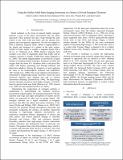Using the Galileo Solid-State Imaging Instrument as a Sensor of Jovian Energetic Electrons
Author(s)
Carlton, Ashley; de Soria-Santacruz Pich, Maria; Kim, Wousik; Jun, Insoo; Cahoy, Kerri
DownloadCarlton Extended Abstract_Submitted_v2.pdf (2.526Mb)
Metadata
Show full item recordAbstract
We quantitatively describe the Jovian energetic electron environment using the Solid State Imager (SSI) on the Galileo spacecraft. We post-process raw SSI images by removing the target object and dark current to obtain frames only with the radiation contribution. The camera settings (gain state, filter, etc.) are used to compute the energy deposited in each pixel, which corresponds to the intensity of the observed radiation hits (the actual measurements are expressed with the digital number (DN), from which the energy deposited can be computed).
Histograms of the number of pixels versus energy deposited by incident particles from processed SSI images are compared with the results from 3D Monte Carlo transport simulations of the SSI using Geant4. We use Geant4 to simulate the response of the SSI instrument to mono-energetic electron environments from 1 to 100 MeV. We fit the modeled instrument response to the SSI data using a linear combination of the simulated mono-energetic histograms to match the SSI observations. We then estimate the spectra of the energetic electron environment at Jupiter, or we estimate the integral flux when there is lower confidence in the spectra fits. We validate the SSI results by comparing the environment predictions to the observations from the Energetic Particle Detector (EPD) on the Galileo spacecraft, examining the electron differential fluxes from 10’s of keV to 11 MeV. For higher energies (up to 31.0 MeV), we compare our findings with the NASA GIRE model, which is based on measurements from the Pioneer spacecraft. This approach could be applied to other sets of imaging data in energetic electron environments, such as from star trackers in geostationary Earth orbits.
Date issued
2018-04-16Keywords
Galileo spacecraft, Geant4, Jupiter radiation environment, Solid-State Imaging (SSI) instrument, high-energy electrons